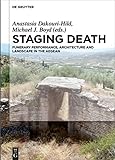Staging Death : Funerary Performance, Architecture and Landscape in the Aegean / Anastasia Dakouri-Hild, Michael John Boyd.
Material type: TextPublisher: Berlin ; Boston : De Gruyter, [2016]Copyright date: ©2017Description: 1 online resource (XI, 398 p.)Content type:
TextPublisher: Berlin ; Boston : De Gruyter, [2016]Copyright date: ©2017Description: 1 online resource (XI, 398 p.)Content type: - 9783110475784
- 9783110479195
- 9783110480573
- Archaeology and history -- Greece
- Archaeology and history -- Greece
- Burial -- Greece
- Burial -- Greece
- Civilization, Aegean -- Greece
- Civilization, Aegean
- Excavations (Archaeology) -- Greece
- Excavations (Archaeology) -- Greece
- Funeral rites and ceremonies -- Greece
- Funeral rites and ceremonies -- Greece
- Landscape archaeology -- Greece
- Landscape archaeology -- Greece
- Death
- Landschaft
- Performativität
- Tod
- landscape
- performance
- HISTORY / Ancient / General
- 930.1 23
- GT3251.A2 S73 2016
- CC77.H5 S72 2016
- online - DeGruyter
| Item type | Current library | Call number | URL | Status | Notes | Barcode | |
|---|---|---|---|---|---|---|---|
 eBook
eBook
|
Biblioteca "Angelicum" Pont. Univ. S.Tommaso d'Aquino Nuvola online | online - DeGruyter (Browse shelf(Opens below)) | Online access | Not for loan (Accesso limitato) | Accesso per gli utenti autorizzati / Access for authorized users | (dgr)9783110480573 |
Frontmatter -- Contents -- Staging Death: an Introduction -- Getting to Funerary Place in a Fairly Short Stretch of Time: Death and Performance in the Prehistoric Aegean -- Funerary Ritual-Architectural Events in the Temple Tomb and the Royal Tomb at Knossos -- Fields of Action in Mycenaean Funerary Practices -- Politics of Death at Mitrou: Two Prepalatial Elite Tombs in a Landscape of Power -- Intra, Extra, Inferus and Supra Mural Burials of the Middle Helladic period: Spatial Diversity in Practice -- The Practice of Funerary Destruction in the Southwest Peloponnese -- A Roof for the Dead: Tomb Design and the ‘Domestication of Death’ in Mycenaean Funerary Architecture -- Revisiting the Tomb: Mortuary Practices in Habitation Areas in the Transition to the Late Bronze Age at Kirrha, Phocis -- Mortuary Practices in the Middle Bronze Age at Kouphovouno: Vernacular Dimensions of the Mortuary Ritual -- ‘Death Is Not the End’: Tracing the Manipulation of Bodies and Other Materials in the Early and Middle Minoan Cemetery at Sissi -- A Posthumanocentric Approach to Funerary Ritual and its Sociohistorical Significance: the Early and Middle Bronze Age Tholos Tombs at Apesokari, Crete -- From Performing Death to Venerating the Ancestors at Lebena Yerokambos, Crete -- Aegean Late Bronze and Early Iron Age Burials in the Ruins of Rulers’ Dwellings: a Legitimisation of Power? -- Continuities and Discontinuities in Helladic Burial Customs During the Bronze Age -- Structuring Space, Performing Rituals, Creating Memories: Towards a Cognitive Map of Early Mycenaean Funerary Behaviour -- Pollution and Purity in the Argolid and Corinthia During the Early Iron Age: the Burials -- Bios -- Index
restricted access online access with authorization star
http://purl.org/coar/access_right/c_16ec
Places are social, lived, ideational landscapes constructed by people as they inhabit their natural and built environment. An ‘archaeology of place’ attempts to move beyond the understanding of the landscape as inert background or static fossil of human behaviour. From a specifically mortuary perspective, this approach entails a focus on the inherently mutable, transient and performative qualities of 'deathscapes': how they are remembered, obliterated, forgotten, reworked, or revisited over time. Despite latent interest in this line of enquiry, few studies have explored the topic explicitly in Aegean archaeology. This book aims to identify ways in which to think about the deathscape as a cross between landscapes, tombs, bodies, and identities, supplementing and expanding upon well explored themes in the field (e.g. tombs as vehicles for the legitimization of power; funerary landscapes as arenas of social and political competition). The volume recasts a wealth of knowledge about Aegean mortuary cultures against a theoretical background, bringing the field up to date with recent developments in the archaeology of place.
Mode of access: Internet via World Wide Web.
In English.
Description based on online resource; title from PDF title page (publisher's Web site, viewed 23. Jul 2020)


